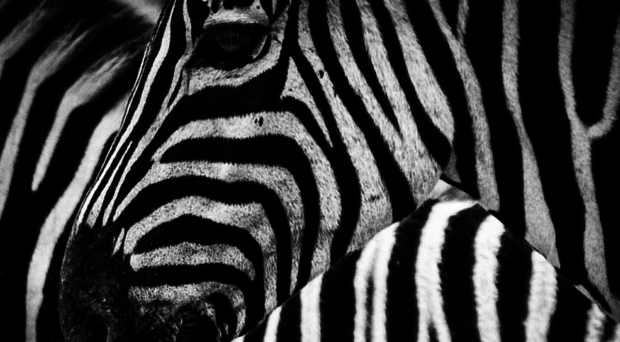
How did the zebra get its stripes?
Surprisingly, the answer to this age-old question is still not known, although there have been many theories.
One suggestion is that the stripes may break up the animal’s outline, making it difficult to identify an individual zebra, particularly in a herd. Other researchers have proposed that the stripes in some way repel tsetse flies, a common blood sucking pest of zebra. Another idea is that the stripes may help the animal to keep cool.
My research focuses on yet another hypothesis: that the stripes may benefit the zebra while it is moving, by making it difficult to track accurately and thus less likely to be captured by predators.
It has been suggested that striking patterns, such as stripes and zigzags, may confuse speed and direction perception, in what has been termed ‘motion dazzle’. This may help to explain the evolution of not only the zebra’s patterns, but also other highly conspicuous geometric patterning seen in species such as snakes and fish. Interestingly, humans have also used these types of patterns to attempt to make military ships more difficult to track.
Until recently, there was little scientific evidence for motion dazzle effects. However, several studies have shown slight benefits for striped targets in computer games where human participants have to attempt to ‘catch’ moving targets by touching them with their finger. In these situations, it seems that striped targets are harder to catch than a range of other pattern types.
…it seems that striped targets are harder to catch than a range of other pattern types.
In the current study, we wanted to ask a couple of new questions about motion dazzle. Firstly, we wanted to know if the effect depends upon the orientation of the stripes. Secondly, we wanted to know whether the effect of stripes might interact with the number of targets present. It is easy to imagine that stripes might be especially confusing and difficult to track in a large group.
We used a similar capture based computer game to previous studies to ask these questions.
Stripes and motion dazzle
Our research found that there was an effect of stripe orientation when subjects were trying to catch individual targets. Targets with stripes oriented parallel to the direction of travel were easier to catch than those with stripes oriented opposite to the direction of motion. It’s not clear why this should be the case yet, but it perhaps reflects the ability of humans to detect motion in multiple ways, with different mechanisms being activated more or less strongly for different orientations of stripes.
Surprisingly, however, we found that all striped targets, regardless of orientation, were easier to capture than a comparison grey target when the number of targets present was increased. This could suggest that the effects of stripes are not enhanced by increased group size.
Of course, this study is preliminary in many ways. Human eyes are different to those of the real predators of zebras, and therefore the effects of stripes on visual perception may also be different.
Similarly, our model of group movement was very basic, with all the targets moving independently from each other: it may be the case that more complex designs, where the targets try to ‘stick together’ in the manner of a real herd would give a different result.
Finally, the evidence for motion dazzle effects of stripes needs to be pieced together with the evidence for the other functions of the zebra’s distinctive pattern, as it is possible that the stripes have evolved for multiple purposes.
Overall, while our study provides evidence that some stripe patterns may provide protection when in motion, the effects seem to depend upon both the orientation of the stripes and whether there are multiple targets present. Whether motion dazzle is a plausible explanation for the mystery of the zebra’s stripes is certainly not solved yet.
- Why do zebras have stripes? - 12th August 2015
Comments